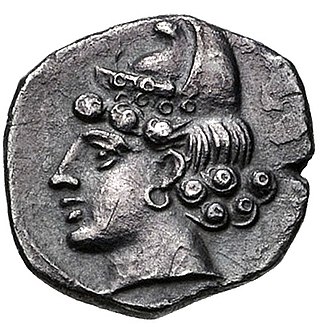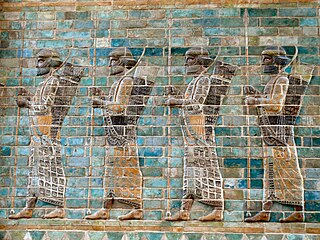Related Research Articles

Alexander III of Macedon, commonly known as Alexander the Great, was a king of the ancient Greek kingdom of Macedon. He succeeded his father Philip II to the throne in 336 BC at the age of 20, and spent most of his ruling years conducting a lengthy military campaign throughout Western Asia and Egypt. By the age of 30, he had created one of the largest empires in history, stretching from Greece to northwestern India. He was undefeated in battle and is widely considered to be one of history's greatest and most successful military commanders.

Darius III was the last Achaemenid King of Kings of Persia, reigning from 336 BC to his death in 330 BC.

Persepolis was the ceremonial capital of the Achaemenid Empire. It is situated in the plains of Marvdasht, encircled by southern Zagros mountains of the Iranian plateau. Modern day Shiraz is situated 60 km (37 mi) southwest of the ruins of Persepolis. The earliest remains of Persepolis date back to 515 BC. It exemplifies the Achaemenid style of architecture. UNESCO declared the ruins of Persepolis a World Heritage Site in 1979.
Bagoas was a prominent Persian official who served as the vizier of the Achaemenid Empire until his death.

Arses, also known by his regnal name Artaxerxes IV, was the twelfth Achaemenid King of Kings from 338 to 336 BC.

The Battle of Gaugamela, also called the Battle of Arbela, took place in 331 BC between the forces of the Army of Macedon under Alexander the Great and the Persian Army under King Darius III. It was the second and final battle between the two kings, and is considered to be the final blow to the Achaemenid Empire, resulting in its complete conquest by Alexander.

Ochus, known by his dynastic name Artaxerxes III, was King of Kings of the Achaemenid Empire from 359/58 to 338 BC. He was the son and successor of Artaxerxes II and his mother was Stateira.

Quintus Curtius Rufus was a Roman historian, probably of the 1st century, author of his only known and only surviving work, Historiae Alexandri Magni, "Histories of Alexander the Great", or more fully Historiarum Alexandri Magni Macedonis Libri Qui Supersunt, "All the Books That Survive of the Histories of Alexander the Great of Macedon." Much of it is missing. Apart from his name on the manuscripts, nothing else certain is known of him. This fact alone has led philologists to believe that he had another historical identity, to which, due to the accidents of time, the link has been broken. A few theories exist. They are treated with varying degrees of credibility by various authors. Meanwhile, the identity of Quintus Curtius Rufus, historian, is maintained separately.

Pasargadae /pə'sɑrgədi/ was the capital of the Achaemenid Empire under Cyrus the Great. Today it is an archaeological site located just north of the town of Madar-e-Soleyman and about 90 kilometres (56 mi) to the northeast of the modern city of Shiraz. It is one of Iran's UNESCO World Heritage Sites. It is considered to be the location of the Tomb of Cyrus, a tomb previously attributed to Madar-e-Soleyman, the "Mother of Solomon".

Cyrus II of Persia, commonly known as Cyrus the Great, was the founder of the Achaemenid Empire, the First Persian Empire. Under his rule the empire embraced all of the previous civilized states of the ancient Near East, expanded vastly and eventually conquered most of Western Asia and much of Central Asia. Spanning from the Mediterranean Sea and Hellespont in the west to the Indus River in the east, the empire created by Cyrus was the largest the world had yet seen. At its maximum extent under his successors, the Achaemenid Empire stretched from parts of the Balkans and Southeast Europe proper in the west to the Indus Valley in the east.

The Persian Boy is a 1972 historical novel written by Mary Renault and narrated by Bagoas, a young Persian from an aristocratic family who is captured by his father's enemies, castrated, and sold as a slave to king Darius III, who makes him his favourite. Eventually he becomes the lover and most faithful servant of Alexander the Great, who overthrew Darius and captured the Persian Empire. Bagoas' narration provides both a Persian view of the conquest and an intimate look at the personality of the conqueror. In Renault's view, Alexander's love for Bagoas influenced his desire to unite the Greek and Persian peoples. Renault also posits the notion that Alexander's relentless drive to conquer the world stemmed in part from his troubled relationship with his domineering mother, and his desire to "escape" from her influence by leading his army ever eastward.
Harpagus, also known as Harpagos or Hypargus, was a Median general from the 6th century BC, credited by Herodotus as having put Cyrus the Great on the throne through his defection during the battle of Pasargadae.

Bagoas was the name of two eunuchs in the court of the Persian Empire in the 4th century BC. Bagoas the Younger was a courtier of Darius III and later of Alexander the Great.

The Achaemenid dynasty was a royal house that ruled the Persian Empire, which eventually stretched from Egypt and the Balkans in the west to Central Asia and the Indus Valley in the east.

The historical and literary tradition describes several of Alexander's relations, some of which are the subject of question among modern historians.

The Battle of the Persian Gate was a military conflict between a Persian force, commanded by the satrap of Persis, Ariobarzanes, and the invading Hellenic League, commanded by Alexander the Great. In the winter of 330 BC, Ariobarzanes led a last stand of the outnumbered Persian forces at the Persian Gates near Persepolis, holding back the Macedonian army for a month. Alexander eventually found a path to the rear of the Persians from the captured prisoners of war or a local shepherd, defeating the Persians and capturing Persepolis.

The Tomb of Cyrus is the final resting place of Cyrus the Great, the founder of the ancient Achaemenid Empire. The mausoleum is located in Pasargadae, an archaeological site in the Fars Province of Iran.

Achaemenid architecture includes all architectural achievements of the Achaemenid Persians manifesting in construction of spectacular cities used for governance and inhabitation, temples made for worship and social gatherings, and mausoleums erected in honor of fallen kings. Achaemenid architecture was influenced by Mesopotamian, Assyrian, Egyptian, Elamite, Lydian, Greek and Median architecture. The quintessential feature of Persian architecture was its eclectic nature with foreign elements, yet producing a unique Persian identity seen in the finished product. Achaemenid architecture is academically classified under Persian architecture in terms of its style and design.

The Achaemenid Empire or Achaemenian Empire was the ancient Iranian empire founded by Cyrus the Great of the Achaemenid dynasty in 550 BC, also known as the First Persian Empire. Based in Western Asia, it was the largest empire the world had ever seen at its time, spanning a total of 5.5 million square kilometres from the Balkans and Egypt in the west to Central Asia and the Indus Valley in the east.

The Histories of Alexander the Great is the only surviving extant Latin biography of Alexander the Great. It was written by the Roman historian Quintus Curtius Rufus in the 1st-century AD, but the earliest surviving manuscript comes from the 9th century.
References
- 1 2 CP Mason - Fellow of University College, London (1873). A Dictionary of Greek and Roman Biography and Mythology, Volume 3. J. Murray, 1873. Retrieved 2015-04-12.
- ↑ Curtius Rufus, Curtius Rufus, Histories of Alexander the Great, Book 10. Translated by J. C. Yardley Oxford University Press, 12 Mar 2009 ISBN 019156785X [Retrieved 2015-04-13]
- ↑ The History of Alexander by Quintus Curtius Rufus